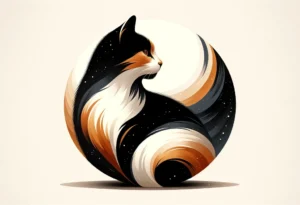Cats in Asia have broken tails for a variety of reasons, sparking curiosity and intrigue among animal lovers. From folklore to scientific explanations, the tales of these cats and their unique tails are as diverse as the continent itself.
Why do cats in Asia have broken tails?
Cultural Beliefs and Superstitions
In many Asian cultures, cats with broken tails are often seen as symbols of good luck and fortune. According to folklore, it is believed that these cats bring prosperity and ward off evil spirits. In Japan, the Maneki Neko, or beckoning cat, is a popular figurine with a broken tail that is believed to bring wealth and success to its owners. Similarly, in China, cats with broken tails are thought to bring in money and good luck.
Genetics and Evolution
The prevalence of broken tails in certain cat breeds in Asia can be attributed to genetics and evolution. Some breeds, such as the Japanese Bobtail, naturally have kinked or curved tails due to genetic mutations. These traits were selected over time through natural selection and breeding practices to adapt to the environment and climate of the region. As a result, broken tails have become common in many Asian cat breeds.
Unique Insight : Cats with broken tails may have a higher chance of survival in the wild due to their ability to maneuver and balance effectively, making them more adaptable to different environments. This trait could have contributed to the widespread presence of cats with broken tails in Asia.
Environmental Factors
In Asia, environmental factors can play a significant role in why cats may have broken tails. For starters, urban areas in Asia are often densely populated and filled with high-rise buildings, making it more likely for cats to suffer injuries from falls. Additionally, some regions experience extreme weather conditions like typhoons or earthquakes, which can also lead to accidents causing broken tails in cats.
Moreover, in rural parts of Asia, cats may encounter predators such as snakes or larger animals, increasing their risk of tail injuries. The diverse landscapes and wildlife in Asia can pose various challenges for cats, contributing to the prevalence of broken tails in feline populations. So, it’s essential to consider the unique environmental conditions when understanding why cats in Asia may have broken tails.
Traditional Practices
Certain traditional practices in Asia can impact the prevalence of cats with broken tails. In some cultures, cats are valued for their hunting abilities but may not receive the same level of veterinary care as pets in Western countries. This lack of medical attention can result in untreated injuries, including broken tails.
Additionally, in some regions, superstitions or beliefs about cats may influence how they are treated when injured. For example, some people may view cats with broken tails as unlucky or not worth the effort to care for, leading to a higher number of cats with untreated injuries. These traditional beliefs and practices can significantly affect the well-being of cats in Asia and contribute to the occurrence of broken tails.
- Additionally, in some regions of Asia, there is a practice of docking cats’ tails for aesthetic purposes or superstitions. This practice can lead to tail injuries and deformities, further contributing to the prevalence of broken tails in the cat population.
- Link: ASPCA
Common Injuries and Accidents
Cats in Asia can often have broken tails due to common injuries and accidents they encounter in their environment. One frequent cause is getting their tails caught in doors, windows, or gates while attempting to navigate through narrow spaces. This can lead to fractures or breaks in their tails, causing them pain and discomfort. Additionally, cats may injure their tails by getting into fights with other animals or falling from heights. Such accidents can result in broken tails, requiring veterinary attention to heal properly.
Unique Adaptations
Cats in Asia have developed unique adaptations to their environment, including the development of broken tails as a survival mechanism. One interesting adaptation is the ability of some cat breeds to intentionally break their own tails as a defense mechanism when faced with predators or other threats. By sacrificing their tails, these cats can escape from dangerous situations without causing harm to their vital organs. This behavior has been observed in certain wild cat species in Asia and showcases the remarkable adaptability of these felines to their surroundings.
Explore the world of cats with this insightful guide: Cats of Asia.
Veterinary Care and Treatment
In Asia, cats with broken tails require prompt veterinary care to ensure proper healing. Upon examination, a veterinarian may recommend various treatment options depending on the severity of the injury. X-rays are often used to assess the extent of the break and determine the best course of action. Pain medication and anti-inflammatory drugs may be prescribed to manage discomfort and swelling. In some cases, splinting or surgical intervention may be necessary to repair the tail. It is crucial for pet owners to follow their vet’s instructions closely to promote a speedy recovery and prevent complications.
Cultural Significance Today
Despite advancements in veterinary care, the cultural significance of cats with broken tails in Asia continues to hold symbolic meanings. In countries like Japan, cats with broken tails are often associated with good fortune and prosperity. They are believed to bring luck to their owners, offering protection and warding off evil spirits. Even in modern times, these beliefs still influence popular culture and superstitions surrounding cats in Asian societies. Embracing these cultural traditions adds a unique and fascinating dimension to the relationship between people and their feline companions in the region.
For more information on caring for cats with broken tails, you can visit the American Society for the Prevention of Cruelty to Animals (ASPCA) website: ASPCA
Did You Know?
Cats with broken tails in Asia often have this unique trait due to a genetic mutation that causes their tails to naturally bend or kink at a certain point. This intriguing feature is more common in certain Asian cat breeds, such as the Japanese Bobtail and the Manx cat. While it may seem unusual to see cats with broken tails, it is actually a natural occurrence that has been observed for centuries in various parts of Asia.
Some interesting trivia about cats with broken tails in Asia includes the belief in some cultures that these cats bring good luck and prosperity to their owners. In Japan, the Japanese Bobtail is considered a symbol of good fortune and is often depicted in artwork and folklore. Similarly, in China, the Manx cat is believed to bring happiness and wealth to those who care for them.
Another fascinating fact is that cats with broken tails are highly valued in certain Asian societies for their unique appearance and perceived mystical qualities. They are sometimes seen as mystical beings or protectors with special powers. This cultural significance has contributed to the popularity of these cats in Asian communities.
In addition to their symbolic meanings, cats with broken tails in Asia are also prized for their intelligence, agility, and loyal nature. Despite their unusual physical feature, these cats are often cherished companions that bring joy and companionship to their owners. So, if you ever come across a cat with a broken tail in Asia, remember that they are not just unique in appearance but also hold a special place in the hearts of many people in the region.
Alex, a passionate animal lover, has experience in training and understanding animal behavior. As a proud pet parent to two dogs and three cats, he founded AnimalReport.net to share insights from animal experts and expand his knowledge of the animal kingdom.




